
This page is part of © FOTW Flags Of The World website
Ciskei (South African homeland)
Last modified: 2025-01-11 by peter hans van den muijzenberg
Keywords: south africa | homeland | ciskei | bird: crane | indwe |
Links: FOTW homepage |
search |
disclaimer and copyright |
write us |
mirrors
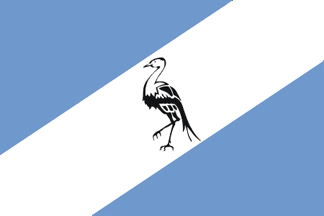 image
by Martin Grieve, 07 Dec 2006
See also:
image
by Martin Grieve, 07 Dec 2006
See also:
Ciskei - introduction
Within the "old" South Africa, 10 homelands were created, four of which
were granted "independence" by South Africa (not recognised by any other
country in the world). These former South African Homelands/bantustans
ceased to exist on 27 April 1994. They have all (including the former so
called independent Homelands) been reincorporated into South Africa.
The flags of the former Homelands are no longer in use (either officially
or unofficially).
Bruce Berry, 25 April 1996
Ciskei was the largest un-segmented bantustan, in south eastern Cape
Province (currently the Eastern Cape).
António Martins, 30 May 1999
Ciskei flag description
The design of the Ciskei flag was originally set out in section 2 of
the Ciskei Flag Act of 1977 which reads as follows:
"The flag of the Ciskei shall be blue with a bend sinister of white,
over all a Blue Crane proper edged white (sic).
The width of the flag shall be equal to two-thirds of its length.
The width of the bend sinister shall be one-sixth of the length of
the flag.
The height of the Blue Crane shall be one-third of the width of the
flag".
The blue in the flag is said to symbolise the infinity of the sky and
the striving for progress and development. The white bar refers to the
path which must be followed in order to bring this development to fruition.
The Blue Crane or "Indwe" is symbolises the desire of the Xhosa people
to be courageous and steadfast and to labour with diligence for the future
of the country and its people. Traditionally those who distinguished themselves
were decorated with feathers of the Blue Crane by the tribal Chief.
Although the official description gives the colours of the "indwe"
as proper, that is in its natural colours, in practise the blue crane was
depicted on the flag in black outline and with black detail.
ck-1.gif) image
by Martin Grieve, 07 Dec 2006
image
by Martin Grieve, 07 Dec 2006
This flag was officially taken into use on 22 June 1977 although it
had in fact first been hoisted outside the Legislative Assembly building
on 15 March 1974.
Ciskei was granted internal self-government on 01 August 1972 and achieved
full "independence" from South Africa on 04 December 1981. A description
of this flag was incorporated into Schedule 3 of the Republic of Ciskei
Constitution Act.
Ciskei was re-incorporated into South Africa on 27 April 1994 and ceased
to exist as a separate political entity and the flag is no longer in use.
The image above shows the design of the Ciskei flag actually used although
this is slightly different from that which is described in the Flag Act.
The design as officially described is as shown below.
Bruce Berry, 01 Dec 1998
I made the image based on what is depicted in the following books:
-
"Flags of the world", Barraclough, 1981. ([c2b81])
-
"Alverdens flag i farver", Pedersen, 1979. ([ped79a])
-
"Flags and arms across the world", Smith, 1980. ([smi80])
-
"Prisma vlaggenboek", Poels, 1990. ([poe90])
-
"Sovereign flags of Southern Africa", Burgers, 1997. ([bur97])
In these books the white stripe is much wider, so the crane fits in it.
On the other hand, in this way the description makes sense when it says "...edged
white" and "...over all...", which doesn't make sense when the crane fits
in the stripe.
Mark Sensen, 01 Dec 1998
Flag of Ciskei seems to be according official description, never used.
The bird must be a bit in the blue parts.
Jaume Ollé, 12 Apr 2001
Regarding the former flags of the South African homelands;
- how much did the actual flags of the homelands differ from the original
specifications, and why?
- how much variation was in between different specimens of the same flag?
- what is the reason for the widely differing representations in flag
publications (Ciskei specifically comes to mind)?
M. Schmöger, 28 Jan 2007
The simple answer to the questions is
manufacturer's licence. There was some variation in the flags made by the
various manufacturers, most notably the
detail for the leopard's head in the flag of Bophuthatswana
and the Blue Crane in the flag of Ciskei. As reported on FOTW, despite the
specifications of the
Ciskei flag as described in the Ciskei Flag Act not conforming to the official
art-card, the proportions of the blue and white stripes were followed as per the
art-card and not as per the specifications. This could possibly explain the
variations in various flag publications (which was actually the official
specification???). However, one manufacturer produced flags showing the twig in
the beak of the Blue Crane (as was the case in the Coat of Arms)
although this
was never specified for the flag. This manufacturer subsequently won a Ciskei
Government contract to supply flags and despite the error being pointed out (by
me actually!!!), the flags were made and the contract honoured!
So you are correct, the majority of the variations were with the Ciskei flag,
while the others were quite minor being mainly different colour shades and in
the case of Venda, different fonts were used for the
"V".
Bruce Berry, 08 Feb 2007
Flag design according to official specifications
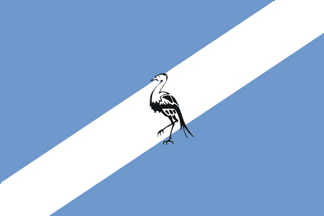 image by Martin Grieve, 07 Dec 2006
image by Martin Grieve, 07 Dec 2006
Ciskei Defence Force flag
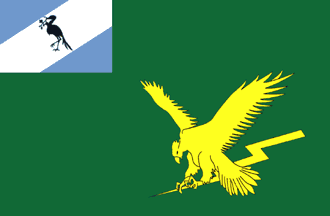 image by Jens Pattke, 19
Aug 2012
image by Jens Pattke, 19
Aug 2012
The flag of the Ciskei Defence
Force has a green field with a large swooping eagle clasping a lightening flash
in gold in the fly. In the canton, only one-ninth of the size of the
field, is the national flag of Ciskei. The blue crane has, incorrectly, a
twig in its beak although examples as such were manufactured as indicated above.
Following the re-incorporation of
Ciskei into South Africa on 27 April 1994, this flag is no longer in use.
Bruce Berry, 19 Aug 2012.
Ciskei Police flag
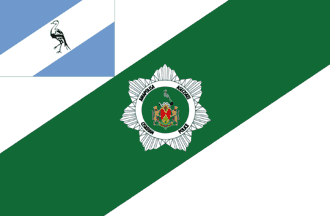 image by Jens Pattke, 19
Aug 2012
image by Jens Pattke, 19
Aug 2012
The Ciskei Police flag has a white field with a dark green sinister diagonal
stripe, charged in the centre with the badge of the Ciskei Police. The badge
comprises a seven-pointed star bearing a black roundel with the Ciskeian
Arms in
full colour, surrounded by an annulet in green, edged in gold, bearing the words
AMAPOLISA ASECISKEI above and CISKEI POLICE below. The national flag of
Ciskei, only one-ninth the size of the field, appears in the canton.
As with the Ciskei Defence Force flag, there are examples where the blue crane
has, incorrectly, a twig in its beak.
Following the re-incorporation of Ciskei into South Africa on 27 April 1994,
this flag is no longer in use.
Bruce Berry, 19 Aug 2012
Ciskei Police - Law Enforcement Division
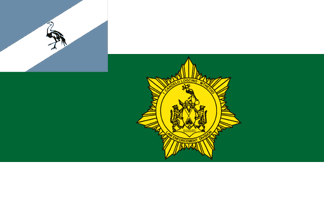 image by Jens Pattke, 20 Jan 2013
image by Jens Pattke, 20 Jan 2013
The flag of the Law Enforcement Division of the Ciskei Police comprises three
horizontal stripes of white, dark green and white, with the Ciskei national flag
in the canton. The central green stripe is double the width of the white
stripes. In the centre of the green stripe is the badge of the Division which
comprises a black outline of the Ciskei Arms in the centre of a yellow
background of a rayed seven pointed star, surrounded by an annulet bearing the
words I CANDELO LOGCION. MTHETHO above and LAW ENFORCEMENT DIVISION, below, all
in black letters. Beneath the arms is the Ciskei motto, SIYAKUNQANDWA
ZIINKWENKWEZI which translates as "Reach for the Stars".
ckled.gif) image by Jens Pattke, 20 Jan 2013
image by Jens Pattke, 20 Jan 2013
Following the reincorporation of Ciskei into South Africa on 27 April 1994, this
flag is no longer being used.
Bruce Berry, 20 Jan 2013
Ciskei Prisons Service flag
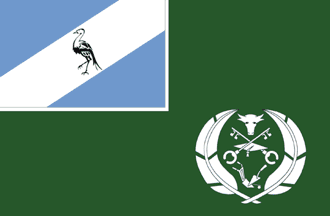 image by Jens Pattke, 19 Aug 2012
image by Jens Pattke, 19 Aug 2012
The flag of the Ciskei Prisons Service has a turquoise field with the Ciskei
national flag, fimbriated in white in the canton, occupying one quarter of the
size of the field. The badge of the Ciskei Prisons Service, in white,
occupies the lower fly.
Following the re-incorporation of Ciskei into South Africa on 27 April 1994,
this flag is no longer in use.
Bruce Berry, 19 Aug 2012
Ciskei Traffic Force flag
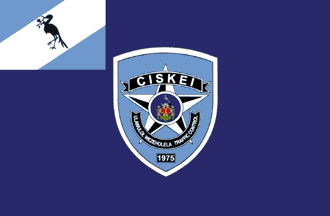 image by Jens Pattke, 19 Aug 2012
image by Jens Pattke, 19 Aug 2012
The flag of the Ciskei Traffic
Force has a dark blue field charged in the centre with the badge of the Force,
namely a light blue shield fimbriated in white, bearing in the centre a five
pointed star faceted black and white. In the centre on a dark blue roundel
is the Ciskei Arms in full colour. Over the upper ray of the star is a
ribbon with the words CISKEI in white, while below over the two lower rays is a
ribbon inscribed ULAWULDLWEZEHOLELA and TRAFFIC CONTROL, and beneath is a
horizontal stripe with the date 1975.
As with the Ciskei Defence Force and Ciskei Police flags, a Ciskei national flag
only one-ninth the size of the field appears in the canton.
The blue crane has, incorrectly, a
twig in its beak although examples as such were manufactured as indicated above.
Following the re-incorporation of Ciskei into South Africa on 27 April 1994,
this flag is no longer in use.
Bruce Berry, 19 Aug 2012
Ciskei Coat of Arms
ck.gif) scan by
Bruce Berry, 07 Dec 2006
scan by
Bruce Berry, 07 Dec 2006
By Government
Notice No.1599, published in the South African Government Gazette (Number
3644 of 8 September 1972) it was notified that a coat of arms had been
registered for the Ciskei Legislative Assembly in terms of the South African
Heraldry Act (Act No. 18 of 1962). Although application and registration was
made in terms of the Heraldry Act (Government Notice 1599 in Government
Gazette 3644 of 08 September 1972), the State Herald did not issue a formal
certificate of registration in respect of these Arms as they had been devised
without consultation of the Bureau of Heraldry. These arms were later
illustrated and described in Schedule 4 of the Republic of Ciskei Constitution
Act (Act No. 20 of 1981). However, a formal certificate of registration (number
1280) was subsequently issued on 15 October 1982 at the request of the
Government of the Republic of Ciskei.
The blazon
for the Arms reads as follows:
Arms:
Pert saltire Or and Gules, in chief a bull's head caboshed proper, in base a
tree on an island Vert; behind the shield an assegai and knobkerrie in saltire
Sable.
Crest:
Four ivory rings conjoined, standing thereon a blue crane holding in his beak a
sprig with nine leaves proper.
Supporters: Two leopards guardant proper
Motto: SIYAKUNQANDWA ZIINKWENKWEZI (Reach for the Stars).
With the
re-incorporation of Ciskei into South Africa in April 1994, these Arms are no
longer in use.
Bruce Berry, 01 Dec 1998
ck-1.gif) image
by Martin Grieve, 07 Dec 2006
image
by Martin Grieve, 07 Dec 2006
 image
by Martin Grieve, 07 Dec 2006
image
by Martin Grieve, 07 Dec 2006
 image by Martin Grieve, 07 Dec 2006
image by Martin Grieve, 07 Dec 2006



ckled.gif)


ck.gif)